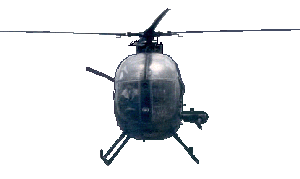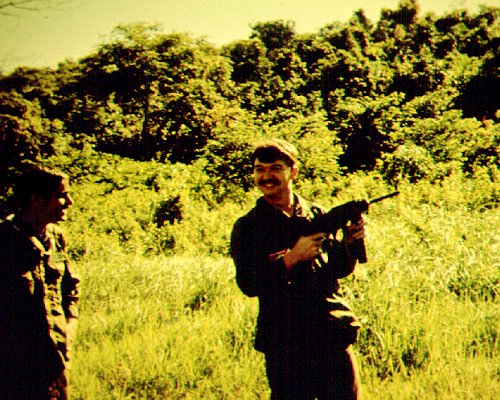
LOW LEVEL AUTOROTATION WITH SPEED REDUCTION CLIMB
By Don Callison
Copyright 1995

Our
unit, D Troop, 3rd Squadron of the 5th Cavalry was
working out of the little airfield at Cao Lahn. We were about twenty
miles
up river from our home base at Vinh Long. I was flying a Hughes
OH6A
Light Observation Helicopter, better known as a “Loach”. I was a
scout pilot with the platoon called the “War Wagons” and I was due for
a ninety day check ride.
Rick Waite, our platoon
leader, had just returned
from Vung Tau where he had completed the OH6A Instructor Pilot course
and
I was to be his very first victim. In spite of those silly,
annoying
regulations that required using an empty aircraft for check flights and
so that my ship, “Pig Pen” could remain combat ready, we decided to use
the helicopter in its mission configuration. Our aircraft were
really
loaded. We carried a mini-gun with 2000 rounds of 7.62mm
ammunition
for it. In the cargo compartment there was a box containing another
1500
rounds for the M60 machine gun we carried in the left front seat. An
Infantry
field pack filled with fragmentation grenades rested on the floor
between
the observers feet on a “chicken plate”. 15 to 20 assorted
non-fragmentary
grenades were hung on wires that had been strung across open spaces
near
the canopy in the top of the cockpit. There were smoke, tear gas,
incendiary,
and Thermite canisters hanging all over the place. We also carried
personal
weapons and lots of other crap. With a full load of fuel, it would be
an
understatement to say we worked heavy. The unit operations officer,
Cpt.
Shetler, once said “The War Wagons usually took off at about 300 pounds
over the maximum allowable gross weight for the helicopter”.
Back
to the story. Rick and I had made a couple
of trips around the traffic pattern for the preliminary stuff.
Then
Rick says he’s going to demonstrate a “pop-up autorotation”. The
maneuver was intended to be used in the event of an engine failure
while
flying low level at high speed. The idea was to be able to rapidly
climb
to a higher altitude while reducing airspeed and then entering
autorotation
for a landing in a better area. The practice maneuver required an entry
airspeed of around 120 knots. Once at 120 the throttle would be closed
to idle and the collective pitch lever would be held in its present
position.
Aft cyclic stick would be applied to initiate a smooth, rapid climb and
the pedals would be adjusted to maintain the ship’s heading. As the
aircraft
climbed the collective would be lowered gradually to keep the rotor rpm
from over speeding. By the time the apex of the climb was reached, the
collective pitch was to be fully lowered and the airspeed reduced to
around
60 knots. From that point the autorotation was in a normal “school
solution”
descent from three or four hundred feet. One of the most important
aspects
of the maneuver was rotor rpm management. The OH6A has a low inertia
type
system which will lose rpm very quickly.
As
Rick had invited, I was “following through”
with him on the controls. He lined up with the runway. We were so heavy
and “dirty” he had to dive to get the aircraft up to about 110 knots as
we came across the tree tops at the end of the strip. He closed the
throttle
and hauled back on the cyclic stick. Boy! Did we climb. I thought Pig
Pen
was going straight up. The exhilarating climb ended at about 300 feet
and
I suddenly got the sensation of negative Gs. The ship got real quiet
inside.
I could only hear the whine of the transmission. Even now I can still
see
the smoke grenade that had become dislodged and was bouncing in slow
motion
between my feet near the stick. My left arm felt weightless as I
grabbed
at the canister a couple of times before I got it and tossed it out the
door. At about that time the ship headed for the ground. I didn’t have
to look at the rotor tachometer to know the rpm was dangerously low, I
could nearly count the blades as they went by. Rick was busy with the
controls
and we were suddenly coming out of the sky like a Simonized manhole
cover.
I think Rick and I were wrestling each other over the controls to get
the
ship flying again. Rick managed to get the engine back up near
operating
rpm. We squeezed out a little forward speed and struggling against each
other, managed grease the helicopter on to the runway. A tribute
to our flying “expertise”, there was no damage to Pig Pen. After we
stopped
sliding we just kind of look at each other real funny like. Rick said
something
like “Damn! I guess that will do it for this check ride”! I tried to
grin
and said “Roger that shit”!
Only
our mamasans knew how scared we were when
they did our laundry.
